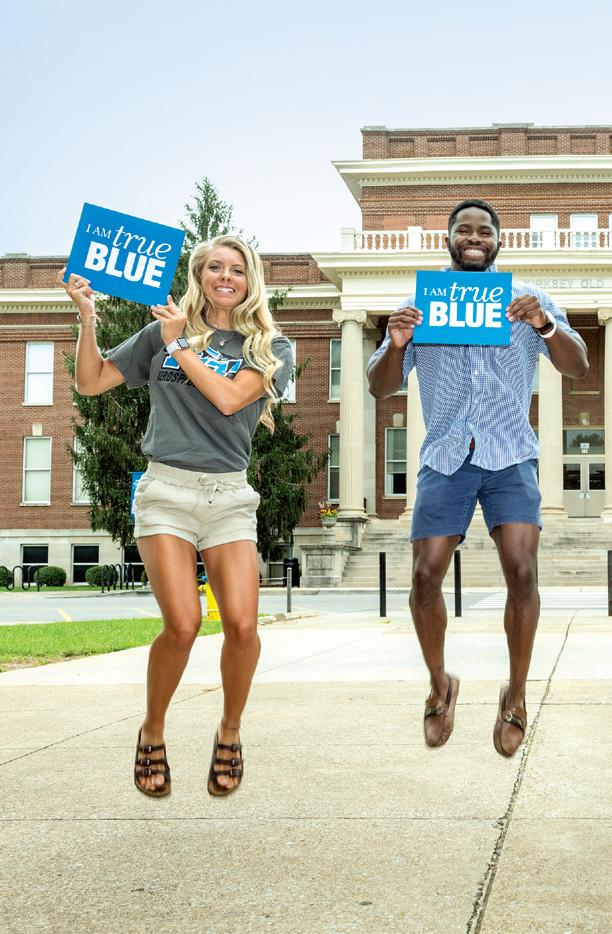
5 minute read
ENGAGE
TRUE INNOVATION
MTSU is continuing to ramp up research efforts at a rapid pace. Scholarly research not only provides the foundation for MTSU’s strong academic programs but also drives innovation and economic progress across the region, state, nation, and globe.
Creating a culture of research and inquiry is at the heart of the University’s mission among faculty and students and in vital industry partnerships. This work often involves undergraduate research opportunities that simply are unique for non-master’s and non-doctoral students at MTSU.
On top of that, MTSU has aggressively transitioned from a primarily undergraduate institution to a doctoral research university with significant research activity. Increasing graduate student enrollment helps strengthen MTSU’s position as a publicly funded research university; enhances MTSU’s reputation as a research institution from both faculty and students’ points of view; meets market need for a more educated workforce in Tennessee, within the region, and across the nation; and increases revenue from both tuition and fees and the state funding formula.

engage 21
During the 2017–18 fiscal year, MTSU submitted 192 proposals for external funding, representing 105 faculty and professional staff serving as principal investigator (PI) or project director (PD) from 46 academic departments, centers, or administrative offices. The University received 55 new grants and contracts by 41 PIs with a total award value of $7,399,000, across 23 departments, centers, and offices. MTSU managed a total of 215 active grants and contracts during 2017–18, with a total portfolio value of $41,458,000. Examples abound of recent awards and proposals illustrating the depth and diversity of excellence and contributions among MTSU employees:
TRUE NUMBERS
Jeremy Strayer (Mathematics) earned a five-year, $727,437 award from the National Science Foundation for “Collaborative Research: Mathematics of Doing, Understanding, Learning and Educating for Secondary Schools.” The project will strive to improve preservice secondary mathematics teachers’ mathematical knowledge for teaching, which is a national need.
55 new grants
$7,399,000 total award value
215 active grants
TRUE HEALTH
Cynthia Chafin (right), associate director of the Center for Health and Human Services, here pictured her with her former intern, Christina Byrd (left), was awarded $554,400 from the Tennessee Department of Health to continue the statewide training to better prepare first responders and medical examiners regarding the “Sudden Infant Death and Death Scene Investigation” program.
$41,458,000 total portfolio value
TRUE VENTURE
During this reporting period, the University continued its commitment to MT Engage, its current Quality Enhancement Plan (QEP) to improve student learning through enhancing the curriculum. The five-year initiative, a requirement by the Southern Association of Colleges and Schools Commission on Colleges (SACSCOC), the regional accreditation body for higher education institutions in the South, affects the entire campus.
MT Engage, which serves as the University’s QEP from 2016 until 2021, reached several milestones midway through its second year.
• Our inaugural MT Engage Sophomore Scholarship competition began. Qualifying sophomores who have taken at least two MT Engage courses submitted ePortfolio presentations in which they document and reflect on connections across their academic and cocurricular experiences. Up to 15 students annually will be selected for scholarships valued at $6,000 (based on cost of attendance), and all qualifying applicants will earn priority registration.
• More than 3,500 students successfully completed MT Engagedesignated courses in Fall 2017, representing 187 sections of 64 courses taught by 98 faculty—already double the benchmarks specified for the full 2017–18 academic year in the MT Engage plan. MT Engage faculty taught a similar number of course sections in Spring 2018 as well.
• The MT Engage leadership team and assistant director wowed their audience at the 2017 Quality Enhancement and Accreditation Institute of the SACSCOC. Dianna Rust, Michelle Boyer-Pennington, Lara Daniel, Lexy Denton, and Jason Vance shared their insights from the development of the MT Engage QEP in their presentation, “Engaging Your Campus with a New Quality Enhancement Plan.”
engage 23



TRUE QUEST retain: “to continue to have (something); keep possession of . . . “to not abolish, discard, or alter . . . “to keep in one’s memory . . .


Launched in 2013, the Quest for Student Success radically rethought the University’s approach to student attrition. While MTSU has always supported at-risk populations, the Office of Student Success we created in 2013 continues to work to boost every student’s chance to succeed.
TRUE SUPPORT

Working collaboratively, the University has overhauled student advising, developed fresh options for academic help, and redesigned courses that are traditional stumbling blocks to graduation.
At the same time, it’s using predictive analytics—an approach more commonly associated with health care than higher ed—to fight attrition in a highly surgical way. Predictive data can help identify students who are at statistical risk of attrition even if they don’t fit into any traditionally “at-risk” population. Armed with this knowledge, faculty and advisors can watch them to spot any problems early and get them back on track. Like our True Blue tradition, I also remain fully committed to the Quest. The results of the Quest have been dramatic, and it has become a standard by which other such initiatives are measured. In 2017, MTSU was one of just 45 American universities invited to join Re-Imagining the First Year, an initiative sponsored by the American Association of State Colleges and Universities and funded by the Bill and Melinda Gates Foundation, to help other institutions improve their student success too. In short, MTSU has become a model nationally for successfully retaining students once enrolled. retain 25
It is well established that some student populations are vulnerable to attrition from day one. Hence, the University routinely performs standard outreach to first-generation and Pell-eligible students, as well as admitted freshmen with lower ACT scores.
But even established college students who don’t fit any “at-risk” demographic and appear to be chugging along in school can have subtle warning signs in their academic record. For example, sophomores and juniors with GPAs between 2.0 and 3.0 have a disproportionately high dropout rate. Because they’re not getting targeted support for being on probation or targeted praise for doing really well, they often get ignored by the institution. These average students, known as “the murky middle,” can fall through the cracks before anyone notices and intervenes.

That’s the sort of trend EAB’s data scientists study. Pulling from 475 million course records provided by the 500 member institutions of EAB’s Student Success Collaborative, they isolate specific academic patterns linked with failure or success in college—whether that’s making a certain grade in a certain class, or taking certain classes in a certain order. Using those subtle historical trends, EAB helps universities like MTSU build predictive risk models based on a decade of their own student data.






